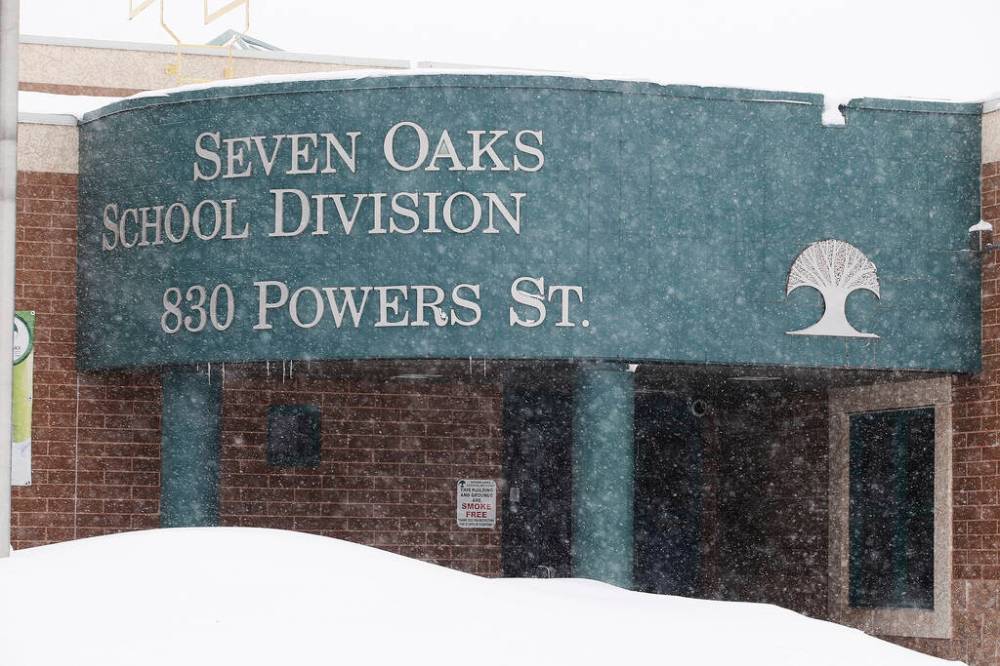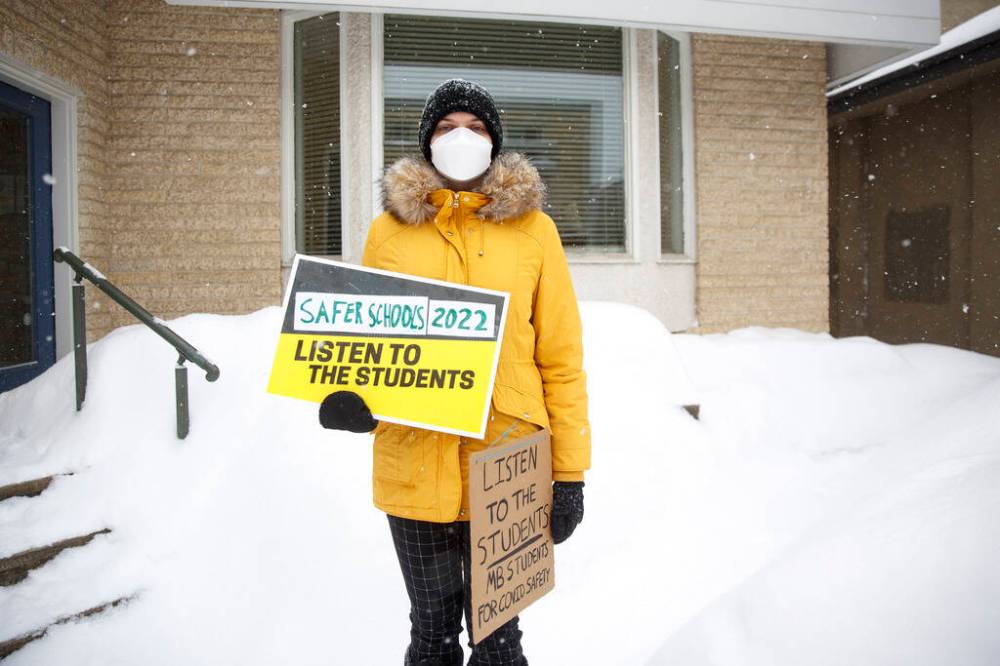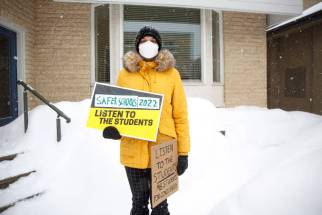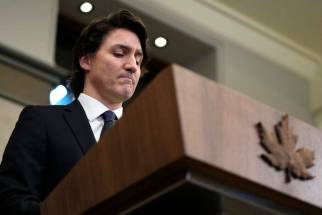Educators cautiously optimistic, students don’t want to get sick Tuesday’s eased pandemic school rules offer administrators hope for return to normal; youths picket MLAs’ offices, urging province to slow down
Read this article for free:
or
Already have an account? Log in here »
To continue reading, please subscribe:
Monthly Digital Subscription
$0 for the first 4 weeks*
- Enjoy unlimited reading on winnipegfreepress.com
- Read the E-Edition, our digital replica newspaper
- Access News Break, our award-winning app
- Play interactive puzzles
*No charge for 4 weeks then price increases to the regular rate of $19.00 plus GST every four weeks. Offer available to new and qualified returning subscribers only. Cancel any time.
Monthly Digital Subscription
$4.75/week*
- Enjoy unlimited reading on winnipegfreepress.com
- Read the E-Edition, our digital replica newspaper
- Access News Break, our award-winning app
- Play interactive puzzles
*Billed as $19 plus GST every four weeks. Cancel any time.
To continue reading, please subscribe:
Add Free Press access to your Brandon Sun subscription for only an additional
$1 for the first 4 weeks*
*Your next subscription payment will increase by $1.00 and you will be charged $16.99 plus GST for four weeks. After four weeks, your payment will increase to $23.99 plus GST every four weeks.
Read unlimited articles for free today:
or
Already have an account? Log in here »
Hey there, time traveller!
This article was published 15/02/2022 (1396 days ago), so information in it may no longer be current.
School leaders are optimistic the latest shuffle of public-health precautions in schools could be one of the last as Manitoba moves towards a new normal after 23 months of COVID-19 disruptions.
Following a month-long stint in the orange-restricted level on the pandemic-response scale, classrooms across the province are once again in yellow-caution mode as of Tuesday.
Students no longer have to wear face coverings during phys-ed classes. School employees can wear non-medical masks if they choose. Unvaccinated student athletes no longer need to undergo frequent rapid testing in order to practise and compete.

Public-health officials have also relaxed a directive about ensuring two metres of physical distancing wherever possible in kindergarten-to-Grade 12 buildings, which means some gymnasiums and music rooms temporarily converted into classrooms have been returned to their normal purposes.
“At the end of the day, physical distance, mask-wearing, hand hygiene, screening for symptoms, ‘stay home when you’re sick’ is still in place, so I feel like we’re still just (pandemic) status quo,” said Lorelei Steffler, principal at St. James Collegiate.
The province’s stated plan to lift mask mandates and other restrictions next month, however, offer hope that school environments may once again operate much like they did before March 2020, Steffler said, adding schools will always enforce healthy practices.
“At the end of the day, physical distance, mask-wearing, hand hygiene, screening for symptoms, ‘stay home when you’re sick’ is still in place, so I feel like we’re still just (pandemic) status quo.” – Lorelei Steffler, principal at St. James Collegiate
Premier Heather Stefanson announced last week that face-covering requirements and remaining precautions will disappear March 15, just over two years after the World Health Organization declared the COVID-19 pandemic.
“The change (Tuesday) was relatively minor. March 15th will, of course, be the big day,” said Ted Fransen, superintendent of Pembina Trails School Division.
While Fransen said he is optimistic that schools will no longer have to react to sudden public-health restrictions after that time, he noted, “March 15th is a lifetime away in COVID world.”

The most recent transition marks at least the sixth time that Winnipeg-area schools have had to adjust to different rules partway through the academic year — in turn, prompting changes to protocols related to masking, physical distancing and extracurricular activities — since the colour-coded scale was created in August 2020.
Some classrooms have experienced even greater disruption during that time.
Between Jan. 17 and Feb. 11, one classroom in one school was directed by public health to move into remote learning and an entire K-12 building moved to distance schooling for three days due to absenteeism rates and operational concerns, according to the province.
During the 2020-21 school year, one teacher in the Seven Oaks School Division had to move his class to remote learning for a two-week period on three separate occasions.

“That’s a lot of work and adjustment for that teacher and those kids,” division superintendent Brian O’Leary said, adding he recalls one principal in north Winnipeg spent three consecutive weekends doing contact tracing at another school last year.
O’Leary said more than 300 students were absent around the time in-person classes resumed in the new year because they had either tested positive for the virus or were self-isolating as a result of a close contact. That number, which relies on parent reports in Seven Oaks, was down to 113 as of Tuesday.
“I really hope (we’re done with e-learning)– especially for little kids. It’s hard to do remote learning when you can’t read yet.” – Brian O’Leary, Seven Oaks School Division superintendent
“We’re not seeing any evidence of spread in schools,” he said, noting vaccine uptake among local high schoolers is above 90 per cent. “I really hope (we’re done with e-learning) — especially for little kids. It’s hard to do remote learning when you can’t read yet.”
At the same time, he said the division is recording an increase in the number of staff stress leaves.
Also Tuesday, MB Students for COVID Safety encouraged its members to show up to MLA offices across Manitoba to protest the province’s plans to continue loosening restrictions.

“I am really terrified and I’m not alone in that. Lots of teachers and parents and students in my school, in my division, and outside, think that the provincial government isn’t supporting the education system enough and is really leaving people behind, in terms of their safety,” said Brie Villeneuve, a student organizer who attends Grant Park High School.
“I am really terrified and I’m not alone in that.” – Brie Villeneuve, student
The Grade 12 student braved flurries to wait outside the Corydon Avenue constituency office of River Heights Liberal MLA Jon Gerrard with protest signs that read: “Do better, Heather” and “Listen to the students” — for an hour during the afternoon.
The grassroots student group continues to call on the province to offer an online learning option, reinstate the requirement that school staff wear medical masks and bring back contact tracing, among other items.
“Restrictions are just reasonable things to do to help the community and make sure that we’re not leaving disabled or marginalized or immunocompromised people behind,” Villeneuve said.
maggie.macintosh@freepress.mb.ca
Twitter: @macintoshmaggie

Maggie Macintosh reports on education for the Winnipeg Free Press. Funding for the Free Press education reporter comes from the Government of Canada through the Local Journalism Initiative.
Our newsroom depends on a growing audience of readers to power our journalism. If you are not a paid reader, please consider becoming a subscriber.
Our newsroom depends on its audience of readers to power our journalism. Thank you for your support.







